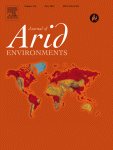Ver ítem
- xmlui.general.dspace_homeCentros Regionales y EEAsCentro Regional La Pampa - San LuisEEA AnguilArtículos científicosxmlui.ArtifactBrowser.ItemViewer.trail
- Inicio
- Centros Regionales y EEAs
- Centro Regional La Pampa - San Luis
- EEA Anguil
- Artículos científicos
- Ver ítem
Comparison of adaptative strategies to climate variability in rural areas of Argentine Chaco and US Southern Plains during the last century
Resumen
Considering uncertainties regarding climate variability, the objective of this study was to make a long-term (1901–2011) comparative assessment of the impact of land-use decision (changes in the cultivated area) and technology adoption as adaptative mechanisms of the rural sector in the Argentine Chaco and the US Southern Plains. Different sources of data on climate (precipitation, minimum, mean and maximum temperature and evapotranspiration), land-use
[ver mas...]
Considering uncertainties regarding climate variability, the objective of this study was to make a long-term (1901–2011) comparative assessment of the impact of land-use decision (changes in the cultivated area) and technology adoption as adaptative mechanisms of the rural sector in the Argentine Chaco and the US Southern Plains. Different sources of data on climate (precipitation, minimum, mean and maximum temperature and evapotranspiration), land-use change (proportion of cultivated area) and technology adoption were used. This work involved three main analytical steps: i) Principal Components Analysis (PCA) was applied to identified the dominant components of data variance, ii) the relationship between the residuals of precipitation and land-use change was assessed by means of a simple regression analysis and iii) technology adoption was evaluated through a proxy based on historical changes in the yield of maize (Zea mays L.). The results showed that farmers in both countries relied on two common adaptative strategies to face climate perturbations during the study period: i) land-use change (a simple binary decision of planting or not planting in response to climate conditions) during a first stage, and ii) the introduction of adaptative technologies to smooth the impact of climate during the second one. That substitution of adaptative strategies begun during the 1940 decade in the US Southern Plains, and around 30 years later in the Argentine Chaco. The adoption of technologies and agronomic practices explained the sensitivity decay of the cultivated area to the climatic variability during the second stage. The incorporation of improved hybrids with higher drought resistance plus the adoption of tilling practices like minimum tillage or no-till, the input of fertilizers, pesticides and irrigation water (the last one in US, only) became a successful strategy to mitigate the risk of climate perturbation.
[Cerrar]

Autor
Ricard, Maria Florencia;
Viglizzo, Ernesto Francisco;
Podestá, Guillermo Pablo;
Fuente
Journal of arid environments 123 : 68-80. (December 2015)
Fecha
2015-12
Editorial
Elsevier
ISSN
0140-1963
Formato
pdf
Tipo de documento
artículo
Palabras Claves
Derechos de acceso
Restringido
 Excepto donde se diga explicitamente, este item se publica bajo la siguiente descripción: Creative Commons Attribution-NonCommercial-ShareAlike 2.5 Unported (CC BY-NC-SA 2.5)
Excepto donde se diga explicitamente, este item se publica bajo la siguiente descripción: Creative Commons Attribution-NonCommercial-ShareAlike 2.5 Unported (CC BY-NC-SA 2.5)

